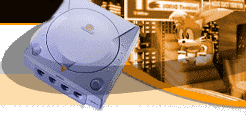Despite it's remarkable similarities to the Diablo games, Record of Lodoss War was clearly designed for a console. The controls are, for the most part, straightforward and intuitive. Menus have been kept to a minimum, and are easily accessed during the game. Spell-casting requires multiple button presses, but this element has been smoothly integrated into gameplay by requiring the player to prepare the spell he intends to use in advance. Once the spell has been prepared, it can be cast at the touch of a button as often as the player wishes (mana permitting).
The learning curve for the control system as a whole is very low. Players will be slaughtering monsters by the bushel in no time at all. The player moves his character with the analog stick. Actions such as talking to characters and picking up items use the "A" button, attacks are on "B," and magic is on "X." Pushing up and down on the directional pad allows the player to scroll through the quick use "belt" along the right side of the screen, and "Y" uses the item currently highlighted. It is possible to rotate the camera 45 degrees in either direction, which can be helpful for surveying a new location for items or monsters that aren't immediately visible.
Screen layout is very clear. A map in the lower left corner automatically updates (like Diablo) as the player moves around the area. Also as in Diablo, the player can choose to overlay the map over the entire screen, superimposing it over the action. While this can be very helpful in certain situations, for the most part, players will likely want to keep the map in its smaller, less obtrusive form. The map is indispensable for finding routes that may not be clearly visible while actually walking around, so most players will not want to turn the map off entirely, although that option is available.
One of the most interesting elements of the game is its system for getting new and more powerful weapons and armor. Early on in the game, the player encounters a dwarven blacksmith. This blacksmith can create a copy of any weapon or piece of armor the player has found up to that point. This is important because most of the time, the player will want to refine the equipment he finds into Mithrill, the crystalline element that serves as the base material for every item in the game. Since items can be refined for the same amount of Mithrill it takes to make them, there is no penalty for refining items aggressively. The blacksmith can easily recreate an item if the player decides he needs it, and in the meantime, the player has more Mithrill to use for other things.

Odd how the developer went with CGI when the series itself is hand drawn. |
First and foremost among these "other things" is the engraving of ancient words onto pieces of armor and weapons. As the player journeys through the world, he encounters plaques containing these ancient words. An ancient word may instill a damage or armor bonus in the item, raise one of the player's stats, or even contain a unique magical power. Each item has a certain number of slots for letters, ranging from three to ten, and each ancient word is made up of a certain number of letters. The player can engrave multiple ancient words at the same time, assuming he has enough letter slots. Words can be engraved temporarily simply by assigning them to the slots. Many of the words, however, can actually be engraved permanently by spending Mithrill to have them permanently etched on the item. This instills the bonus associated with those ancient words while simultaneously freeing the slots for another ancient word.
Items can be transformed from their current forms into other items of the same type (a sword, for example, could only be transformed into another sword, not a helmet). This is another function of the blacksmith. When items are transformed, all permanent enchantments from ancient words transform with the items, allowing for increasingly powerful items as play continues. Unlike Diablo, weapons and armor thankfully never break during use.
The player is introduced to all the controls and tools he will need to play the game during a tutorial at the beginning of the game. The player assumes the role of a mysterious hero, summoned back from the dead to stop a plot to resurrect an evil goddess. His benefactor, Wort (mistakenly spelled "Wart" throughout the game), begins by walking the player through a series of rooms that explain how to fight, open various types of chests, and use items. Once these tutorials are finished, the player is sent off into the real world to get down to the serious business and hacking and slashing.
The game is tough going, especially early on. It turns out, however, that other heroes are also aware that evil is stirring and are trying to stop it. One of the player's first tasks, after setting up a base of operations, is making contact with these fellow agents of goodness and righteousness. Once the player has found a few friends, things get much easier, especially since the player gets experience every time one of his friends kills something. Enter Parn, Deedlit and Slayn.

